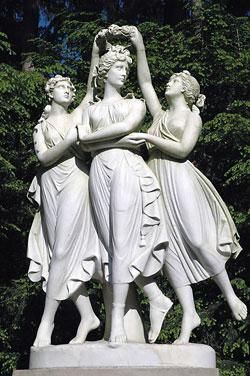2010 Vacation/Travel Supplement
Art park: Indianapolis Museum of Art blends sculptures and recreation

This Grecian sculpture of three women is among the ornate statues on the elegant and historic grounds of the Indianapolis Museum of Art adjacent to West 38th Street and Michigan Road in Indianapolis. (Photo by Mary Ann Wyand)
By Mary Ann Wyand
Lace up your hiking books, clip on a pedometer, fill a backpack with picnic supplies and enjoy a fun day at the newest, most unusual art park in the United States.
There are amazing surprises—unique, contemporary sculptures—nestled in the woods, fields and complementing the lake at
100 Acres: The Virginia B. Fairbanks Art and Nature Park on the scenic grounds of the Indianapolis Museum of Art in Indianapolis.
Bordered by West 38th Street and Michigan Road, the free art museum welcomes visitors of all ages. There is an admission fee for special exhibits.
The family friendly art park, which also is free, opens on Father’s Day, June 20, and is a great way to celebrate summer, admire artwork, explore nature and exercise at the same time.
This nature preserve just west of the museum’s 52-acre, elegant, landscaped grounds—which date back to the 19th century—is a pristine environment and perfect site for a 21st-century sculpture park.
Eight sculptural works installed in or around Hidden Lake and elsewhere in the 100-acre nature park were created by artists from throughout the world with environmentally sensitive materials that deteriorate naturally or have no adverse effects on the land and waterways.
The wooded property also functions as a flood plain for the nearby White River and Indianapolis Water Company’s Central Canal so expect to see—and respect—the numerous wildlife species living there.
“The IMA is one of the few museums in the country that has a lot of land that could be developed from scratch in relation to a sculpture park,” explained Lisa Freiman, the chair of the museum’s department of contemporary art and director of 100 Acres.
“We decided to approach the park [design] as a site that is in constant change,” Freiman said. “… We came up with the idea of commissioning artists to respond to the site itself.”
The museum has owned the land with a 35-acre lake since 1972, she said. About 15 years ago, staff members started discussing plans to develop the nature preserve as a sculpture park.
Freiman, who joined the museum staff eight years ago, said she envisioned the art and nature park as “a platform for artistic
experimentation for artists from around the world” so installations will be added annually or removed at appropriate times.
“Free Basket,” a Surrealist-inspired sculpture, “draws on the form of a basketball court,” and was created by Los Carpinteros, a Cuban artist collective. This huge work of art is a permanent installation, and also functions as an interactive space for creative play at the loop entrance to the park just off West 38th Street.
Other installations range from “Funky Bones”—20 bone-shaped benches which form a huge skeleton—by Dutch artist Joep van Lieshout and his studio, Atelier Van Lieshout, to “Eden II”—a sculpture of a ship emerging from the lake that represents “refugees from the effects of worldwide climate change”—by Finnish artist Tea Mäkipää.
“We will be evaluating the works to see how they hold up over time,” Freiman said, “then making decisions about how long they will be in place. The idea is that each year we will announce a new artist we’re working with, … and probably have a summer solstice party outside to celebrate the opening of the new installations.”
The art and nature park “is going to be changing on an on-going basis,” she said. “It will stay fresh so people will be able to keep coming back and having new experiences.”
People can bring dogs and picnic food into the park, Freiman said, as long as they clean up after themselves and their pets.
The old hiking rule of “carry out what you carry in” to a nature preserve applies here, she said, although trash receptacles will be placed along trails.
“We really want to keep it a special, pristine place, which is one of the things that is so beautiful about it,” Freiman said. “I think most people will respect that [rule] because they’re going to value the space and the unique addition that it brings to Indianapolis.”
The historic Indianapolis Museum of Art property was originally Oldfields, the J.K. Lilly Jr. family’s estate, and classical sculptures throughout the museum grounds blend yesteryear with today.
“I often describe the museum property in three parts,” Freiman said. “Oldfields is the 19th-century and early 20th-century vision of a park. Then there is the museum, which is modern, and now the new art and nature park, which is a 21st-century investigation into the way that art can relate to the world.”
Museum staff members are looking forward to the free public celebration on June 20 at the art park, she said. “I think it’s going to be the best gig in town in terms of having a memorable Father’s Day experience.”
Visitors will enjoy tours, music and dance performances, and games for children, she said, and will be able to purchase box lunches, water and ice cream on the museum grounds.
“It’s going to be a creative festival outside in a beautiful new place,” Freiman said. “We want to open it up to everyone who wants to be there … to see what’s in their backyard now, and to make sure that they take advantage of it and have a really special time. It’s going to be a huge attraction in the city for people who live here, but also for people outside of the city. We want people to use it and become part of the IMA family.”
(For more information about the Indianapolis Museum of Art hours, exhibits and programs as well as 100 Acres: The Virginia B. Fairbanks Art and Nature Park, log on to www.imamuseum.org.) †
